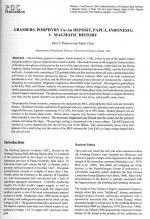Добрый день, Коллеги. Важное сообщение, просьба принять участие. Музей Ферсмана ищет помощь для реставрационных работ в помещении. Подробности по ссылке
Grasberg Porphyry Cu-Au Deposit, Papua, Indonesia: Magmatic History
The Grasberg Igneous Complex, which formed at ~3 Ma, is host to one of the largest copper and gold porphyry-type ore deposits discovered on Earth. This study focuses on the magmatic characteristics of the three main phases of intrusion at the level of the open pit mine: the Dalam, subdivided into the Dalam Andesite, Dalam Volcanic and Dalam Fragmental, the Main Grasberg Intrusion (MGI), and the Kali (Early and Late). A sample suite consisting of 225 polished slabs and thin sections shows all units contain plagioclase and biotite as the dominant phenocryst phases. The Dalam Andesite, MGI and Late Kali contain(ed) hornblende as well. The Late Kali and the MGI also contained minor amounts of clinopyroxene. Apatite is ubiquitous as a trace phase. Magmatic magnetite is identifiable in the Late Kali. The magmatic groundmass in the Kali, MGI, and Dalam Andesite was potassium feldspar, albitic plagioclase, quartz and biotite. A similar groundmass assemblage probably existed in the other Dalam phase rocks, but hydrothermal alteration caused complete replacement. The phenocryst assemblages record no profound changes in magma chemistry over time, but the parent chamber was probably recharged at least twice, and possibly many times.
The porphyritic Dalam Andesite, comparatively equigranular MGI, and porphyritic Kali units are texturally distinct. The Dalam Volcanic and Dalam Fragmental units are, respectively, polymict and monomict matrix-supported breccias, typically containing 5% to 10%, but locally up to 30% clasts. Broken phenocrysts are common in the Dalam phase rocks. Dalam phase magmas only became volatile-saturated and explosive when intruded to near the surface. The monomict fragmental unit formed near the centre and the polymict volcanic unit along the edges. The geologic setting is interpreted to be a maar caldera. The MGI passively intruded as a cone shaped plug into the still hot core of the Dalam. The volumetrically minor Early Kali appears to be a small plug into the centre of the MGI whereas the Late Kali is a large wedge-shaped dyke that cuts all units.




